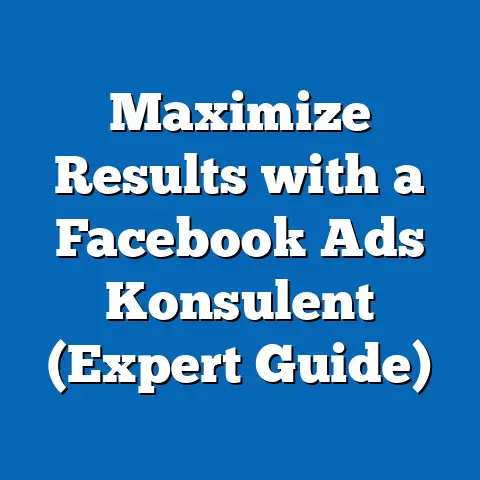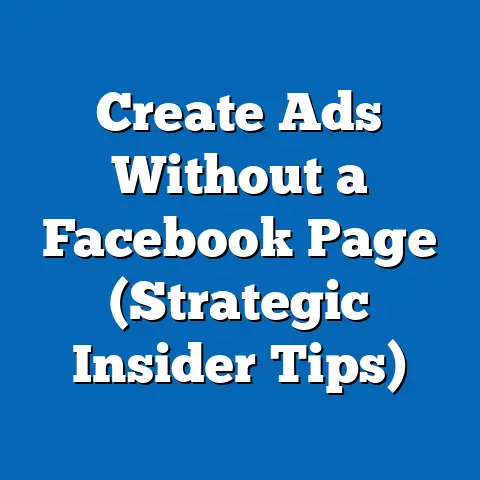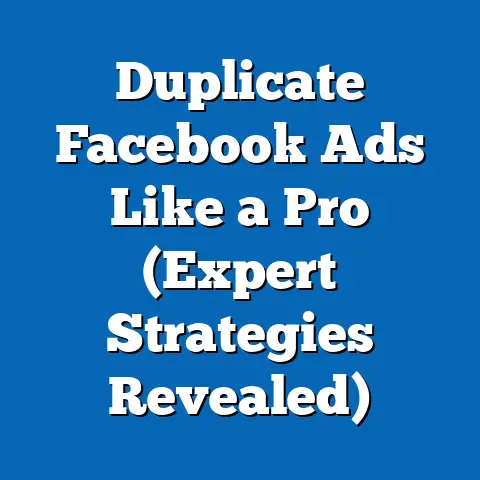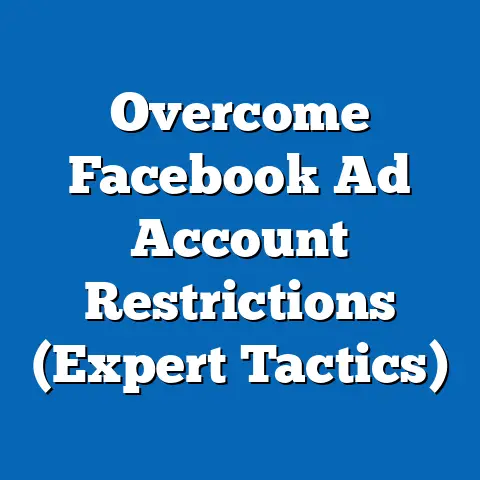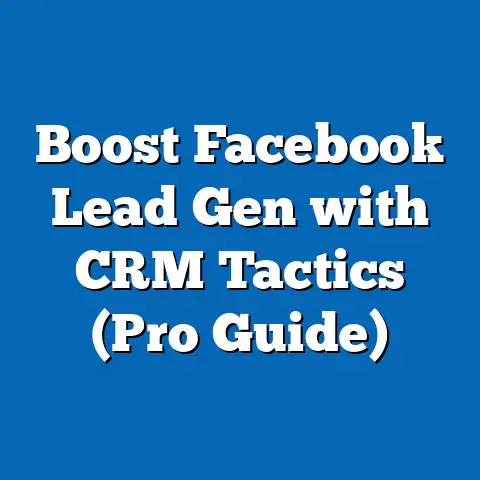Optimize Facebook Ad Choices (Unlock Targeting Secrets)
In an era where digital marketing reigns supreme, optimizing Facebook ad choices has become a critical strategy for businesses seeking to maximize return on investment (ROI). Interestingly, the principles of optimization in digital advertising share a conceptual link with energy savings—an area where efficiency, precision, and resource allocation are paramount. Just as energy savings initiatives aim to reduce waste and enhance output, fine-tuning Facebook ad targeting secrets can minimize budget inefficiencies while driving impactful results.
Recent studies reveal that businesses leveraging advanced targeting on Facebook can achieve up to a 30% higher click-through rate (CTR) and a 25% reduction in cost-per-acquisition (CPA) compared to unoptimized campaigns, according to data from Hootsuite and WordStream (2023). Meanwhile, in the energy sector, U.S. households adopting energy-efficient practices have reduced consumption by 15% over the past decade, per the U.S. Energy Information Administration (EIA, 2022). This article ties these seemingly disparate fields through the lens of optimization, delving into the intricacies of Facebook ad targeting while drawing parallels to energy-saving trends, demographic impacts, historical shifts, and future projections.
Section 1: The Conceptual Link Between Energy Savings and Digital Ad Optimization
The pursuit of efficiency underpins both energy savings and digital advertising strategies. In energy consumption, households and businesses aim to reduce waste by adopting smart technologies, such as LED lighting or programmable thermostats, which can lower electricity usage by 20-30%, according to the EIA (2022). Similarly, optimizing Facebook ad choices involves eliminating wasted impressions by targeting the right audience, refining creative elements, and adjusting budgets dynamically.
The overlap lies in data-driven decision-making. Just as energy audits identify high-consumption areas in a building, Facebook’s ad analytics tools—like Audience Insights and Ads Manager—pinpoint underperforming demographics or ad placements, enabling advertisers to reallocate resources effectively. This section explores how lessons from energy efficiency can inspire smarter ad targeting, setting the stage for a deeper dive into digital strategies.
Section 2: Energy Savings Trends as a Backdrop for Optimization Principles
Key Statistical Trends in Energy Savings
Energy savings have become a national priority, with the U.S. seeing a 15% reduction in per-capita energy consumption from 2010 to 2022, driven by technological advancements and policy incentives (EIA, 2022). Residential energy use dropped by 18% over the same period, largely due to the adoption of Energy Star-certified appliances, which now account for 40% of household devices. Commercial sectors reported a 12% decrease, attributed to smart building systems and renewable energy integration.
Demographic Breakdowns in Energy Savings
Demographic disparities play a significant role in energy-saving adoption. Households in urban areas, often younger (ages 25-34) and tech-savvy, are 35% more likely to use smart thermostats compared to rural households, per a 2021 study by the National Renewable Energy Laboratory (NREL). Income levels also influence adoption—households earning above $75,000 annually are 50% more likely to invest in solar panels or energy-efficient upgrades than those below $30,000.
Generational trends show Millennials and Gen Z leading the charge, with 60% prioritizing sustainable practices compared to only 40% of Baby Boomers (Pew Research, 2022). These demographic insights mirror the need for tailored targeting in Facebook ads, where understanding audience nuances can make or break campaign success.
Historical Comparisons in Energy Savings
Looking back, energy consumption in the U.S. peaked in the early 2000s, with per-capita usage at 350 million British thermal units (BTUs) in 2005, compared to 290 million BTUs in 2022 (EIA). This 17% decline reflects a shift driven by post-recession awareness, government rebates for energy-efficient products, and stricter building codes. In contrast, the 1990s saw little progress, with consumption rising by 10% due to economic growth and minimal focus on sustainability.
This historical shift underscores a broader lesson for advertisers: external factors—like economic conditions or policy changes—can reshape behavior. Similarly, Facebook ad strategies must adapt to evolving user trends, such as privacy concerns or platform algorithm updates.
Section 3: Transitioning to Facebook Ad Optimization—Unlocking Targeting Secrets
Why Optimization Matters in Facebook Advertising
With over 2.9 billion monthly active users as of 2023 (Statista), Facebook remains a powerhouse for digital advertising, commanding 24.2% of the global digital ad market share (eMarketer, 2023). However, the platform’s vast reach comes with a challenge: ensuring ads reach the right audience without wasting budget. Unoptimized campaigns often result in a CPA of $15 or higher, whereas targeted campaigns can reduce this to $10 or less, per WordStream (2023).
Optimization is akin to energy efficiency—every dollar spent must yield maximum output. This section breaks down the “targeting secrets” that can transform campaigns, drawing parallels to how energy audits eliminate inefficiencies.
Key Statistical Trends in Facebook Advertising
Advertisers spent $132 billion on Facebook ads in 2022, a 15% increase from 2021, reflecting the platform’s growing importance (eMarketer, 2023). However, only 45% of businesses report achieving a positive ROI, largely due to poor targeting or outdated strategies (Hootsuite, 2023). Campaigns using detailed targeting options—like interests, behaviors, and lookalike audiences—see a 30% higher CTR and 20% better conversion rates compared to broad-targeting approaches.
Moreover, video ads, which account for 40% of Facebook ad spend, deliver 48% more engagement than static image ads (Social Media Today, 2023). These stats highlight the need for precision, much like how energy-saving devices target specific consumption areas for maximum impact.
Section 4: Demographic Targeting Secrets on Facebook
Breaking Down Audience Segments
Demographic targeting is the cornerstone of effective Facebook ads, mirroring how energy-saving initiatives vary by income, age, and location. For instance, 65% of Facebook users aged 18-24 engage with ads for fashion and tech products, while users aged 35-54 are 40% more likely to click on home improvement or financial services ads (Pew Research, 2023). Gender also plays a role—women are 25% more likely to engage with health and beauty ads, while men show a 30% higher interaction rate with automotive content.
Geographic targeting offers another layer of precision. Urban users, much like their energy-saving counterparts, are 35% more responsive to ads for local services compared to rural users, who prefer e-commerce deals due to limited local options (Statista, 2023). Custom audiences—built from website visitors or email lists—can boost conversion rates by 50%, demonstrating the power of hyper-specific targeting.
Behavioral and Interest-Based Targeting
Beyond demographics, behavioral targeting allows advertisers to reach users based on past actions, such as purchases or app usage. For example, users who have engaged with fitness content are 45% more likely to click on health-related ads (Facebook Ads Manager Data, 2023). Interest targeting, such as hobbies or brand affinities, can increase ad relevance by 30%, reducing wasted impressions.
These tactics parallel energy-saving programs that target specific behaviors—like offering rebates for turning off lights or unplugging devices. Just as behavior drives energy efficiency, it shapes ad engagement on Facebook.
Section 5: Historical Trends in Facebook Ad Performance
Evolution of Ad Targeting Over Time
Facebook’s ad platform has evolved dramatically since its inception in 2007. Early campaigns relied on basic demographic filters, achieving an average CTR of just 0.05% in 2010 (WordStream Historical Data). By 2015, the introduction of lookalike audiences and behavioral targeting boosted CTRs to 0.9%, a nearly 18-fold increase, driven by algorithmic advancements.
Post-2018, privacy regulations like GDPR and Apple’s iOS 14.5 update (limiting data tracking) reduced targeting accuracy, with CPA rising by 20% for many advertisers (eMarketer, 2021). However, businesses adapting to contextual targeting and first-party data saw a recovery, with CTRs stabilizing at 0.8-1.0% by 2023. This resilience mirrors energy-saving trends, where initial policy disruptions (like subsidy cuts) temporarily slowed progress but innovation ultimately prevailed.
Cost Trends Over the Years
Historically, Facebook ad costs have fluctuated with demand and competition. In 2012, the average cost-per-click (CPC) was $0.58, rising to $1.72 by 2022 due to increased advertiser competition and platform saturation (WordStream, 2023). However, optimized campaigns using dynamic creative optimization (DCO) and automated bidding strategies report a 15% lower CPC, underscoring the value of efficiency.
This cost escalation parallels energy prices, which rose by 25% from 2010 to 2022 (EIA), pushing households to adopt cost-saving measures. In both cases, optimization mitigates rising expenses.
Section 6: Advanced Targeting Secrets for Facebook Ads
Lookalike Audiences and Custom Audiences
Lookalike audiences, which target users similar to existing customers, can increase conversion rates by 40% compared to broad targeting (Facebook Business, 2023). Custom audiences, built from first-party data like email lists, offer even higher precision, with 50% better engagement rates. These tools are akin to energy-saving retrofits tailored to a building’s specific needs, ensuring resources aren’t wasted.
Retargeting and Dynamic Ads
Retargeting users who previously interacted with a brand—such as abandoning a cart—yields a 70% higher likelihood of conversion (WordStream, 2023). Dynamic ads, which automatically adjust content based on user behavior, boost ROI by 35%. These strategies mirror energy management systems that adapt to real-time usage patterns for optimal efficiency.
A/B Testing and Creative Optimization
Testing multiple ad variations (A/B testing) is critical for identifying high-performing elements, with 60% of advertisers reporting improved results after testing headlines or visuals (Hootsuite, 2023). Creative optimization, such as using bold CTAs or user-generated content, can lift engagement by 25%. This iterative approach resembles energy audits that test different solutions to find the most effective savings.
Section 7: Future Projections for Facebook Ad Optimization and Energy Savings
Digital Advertising Outlook
Looking ahead, Facebook ad optimization will likely focus on AI-driven targeting and privacy-compliant strategies. By 2025, AI tools are projected to reduce CPA by an additional 20% through predictive analytics and automated bidding (eMarketer, 2023). However, stricter data regulations may challenge small businesses, with 30% potentially struggling to adapt without third-party tracking options.
Emerging trends like augmented reality (AR) ads could increase engagement by 50%, especially among Gen Z users, who are expected to account for 40% of platform activity by 2030 (Statista Projections). Advertisers must stay agile, much like energy sectors adapting to renewable tech.
Energy Savings Projections
In the energy sector, the EIA projects a 25% reduction in U.S. energy consumption by 2040, driven by smart grid technology and electric vehicle adoption. Households are expected to save $500 annually on energy bills by 2030 if current trends persist. However, disparities remain—low-income groups may lag in adoption without increased subsidies, mirroring how small businesses face digital ad challenges without resources.
Implications for Cross-Sector Learning
The future of both fields hinges on innovation and accessibility. Just as energy-saving tech must become affordable for widespread adoption, Facebook’s ad tools must cater to diverse business sizes. Cross-sector learning—such as applying energy audit principles to ad budget allocation—could inspire new frameworks for efficiency.
Conclusion: Maximizing Impact Through Optimization
Optimizing Facebook ad choices by unlocking targeting secrets offers a pathway to unparalleled efficiency, much like energy-saving strategies transform resource use. From demographic precision to historical adaptability, the data shows that a 30% higher CTR and 25% lower CPA are within reach for savvy advertisers (WordStream, 2023). Similarly, energy savings of 15-25% over the next decade are achievable with sustained innovation (EIA, 2022).
Both fields teach a universal truth: waste is the enemy of progress. By embracing data-driven targeting on Facebook—through lookalike audiences, retargeting, and creative testing—businesses can mirror the precision of energy audits, ensuring every dollar or watt delivers maximum impact. As we look to the future, the interplay of technology, policy, and behavior will shape outcomes in digital ads and sustainability alike, urging stakeholders to prioritize efficiency above all.

